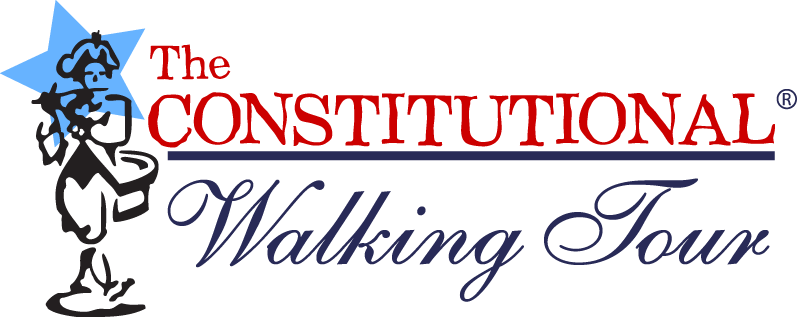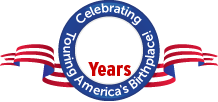Related Posts:
Let Freedom Ring
On The Constitutional Walking Tour, we proudly share the history and significance of the Liberty Bell, which we believe is the quintessential icon of American freedom. When we say quintessential, we mean “the best example”, and when we say icon, we mean “symbol”. In other words, we believe that the Liberty Bell is the best symbol of American freedom. To that end, the Liberty Bell is best known for its crack and the biblical inscription on it that reads, “Proclaim LIBERTY Throughout all the Land unto all the Inhabitants Thereof.” In this blog, we will share the story with you about how the Liberty Bell, which weighs about 2,000 pounds, became the global icon that it is today and one of the most visited tourist attractions in the United States.
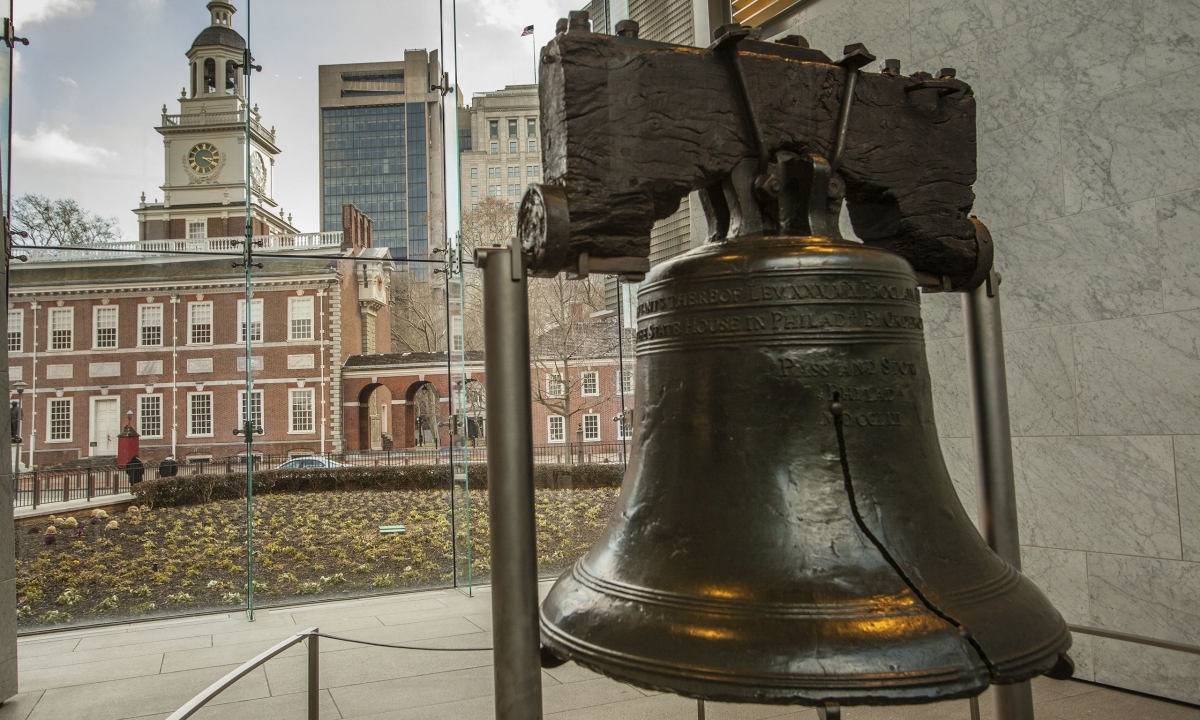
The Liberty Bell with Independence Hall in the Background
Related Posts:
The Making of the Liberty Bell
For more than 300 years, Philadelphia has always had a city bell to announce public gatherings or alert the public to civic danger. It is said that the first bell used for these signaling purposes was actually brought to the city by William Penn himself, the founder of Philadelphia. With the construction of Independence Hall (then known as the Pennsylvania State House) in 1732, the bell was moved to the grounds behind Independence Hall, and it was hung from a tree. But as Philadelphia grew in population, stature and wealth, it would not be long before plans were developed for a proper bell tower to be built as an addition to Independence Hall. As construction on the bell tower began in 1751, city leaders also decided that a grand new bell should hang in the tower.
In 1752, the Colonial government of Pennsylvania sent word to their agent in London and requested that he purchase a bell. They requested that the bell should be by the “best workmen and examined carefully before it is shipped.” Their agent subsequently purchased a copper bell that weighed roughly one ton from the
Whitechapel Bell Foundry Ltd. in London. The Whitechapel Bell Foundry was highly regarded and has managed to stay in business for nearly 450 years, manufacturing other famous bells such as the bell inside “Big Ben” in London. However, for some unknown reason, the Liberty Bell was not nearly as successfully made as most of the other bells that the Whitechapel Bell Foundry had cast. Before the Liberty Bell was even hung in Independence Hall, a test ringing cracked the bell. After attempts to return the bell proved unsuccessful, the Liberty Bell was recast here in Philadelphia by John Pass and John Stow.
Pass and Stow recast the Liberty Bell, possibly adding additional metal alloys to the bell as analysis of the bell shows the presence of a significant amount of tin, some lead and zinc, as well as other alloys that today compose the bell. However, the first attempt from Pass and Stow was deemed unsatisfactory. A third casting was finally a success, and the completed Liberty Bell, which weighs about 1 ton, was finally hung in the now completed bell tower of Independence Hall in June of 1753.
Hear Ye! Hear Ye! - Announcing Independence
On July 4, 1776, the Second Continental Congress famously approved the Declaration of Independence while meeting inside of Independence Hall. However, most Americans did not receive the news immediately since news traveled very slowly in those days. Even in Philadelphia, the majority of the populace was unaware of The Declaration of Independence until four days later on July 8th 1776. On that day, at noon, thousands of Philadelphians gathered in the square behind Independence Hall and heard Colonel John Nixon of the Pennsylvania Militia, publicly read The Declaration of Independence for the very first time. It is believed that the Liberty Bell rang to announce this momentous public reading.
The Crack
The Liberty Bell’s first crack, the one that required Pass and Stow to recast the bell, would unfortunately not be the bell’s last crack. However, unlike the first cracking of the Liberty Bell, there is much less information about the second crack. It is unclear when the second crack even occurred, much less what caused it. What is certain is that after cracking again, there was an attempt to repair the cracked bell. We also know that the repaired Liberty Bell was rung in celebration of
George Washington’s birthday in 1846, and that the repairs failed again on that day. The crack greatly extended to the crown of the bell, placing the bell beyond repair and forever silencing the Liberty Bell.
When viewing the Liberty Bell, most people think the location of the bell’s crack is obvious. However, what most people believe is the Liberty Bell’s crack is in fact the attempted repair of the bell. If you look closely at the giant gash that runs down the Liberty Bell, you will notice that this is no natural crack, and you will see clear markings that were machine made. In an attempted repair, a drill was used to separate the two sides of the cracked Liberty Bell to prevent the two sides from rubbing together when rung, because they believed that continued friction would further damage the bell.
If you want to see the actual crack that silenced the Liberty Bell you have to look very closely. Follow the big man-made gap up to its end point, right between the “P” and “H” in “Philad”. From there, if you are really standing close to the Liberty Bell, you will be able to see a very small hairline fracture that extends diagonally to the right, all the way up to the top of the Liberty Bell where it happens to intersect directly through the word “Liberty”. This hairline fracture is the crack that silenced the Liberty Bell on George Washington’s Birthday in 1846.
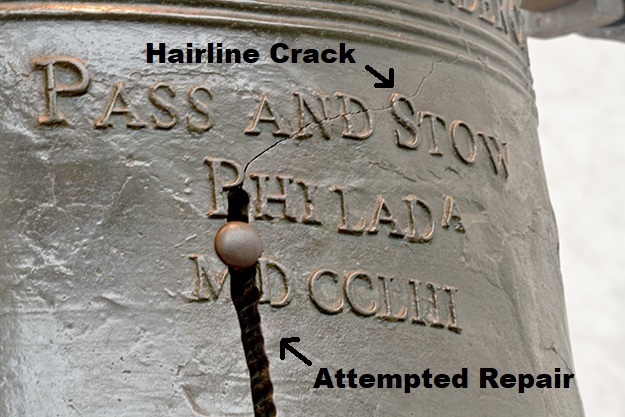
View of the Hairline Crack that silenced The Liberty Bell above the attempted repair
Becoming a National Icon
The story of the Liberty Bell was not widely known at the time of the Revolutionary War, when the Liberty Bell was simply referred to as the Pennsylvania State House Bell. It was not until half a century later, in the 1830s that the Liberty Bell began to become famous. It was during this time that Liberty Bell had begun to be used as a symbol of the Abolitionist Movement. The Liberty Bell was chosen as a symbol of this movement largely due to the Biblical inscription from Leviticus 25, verse 10, which reads, “Proclaim LIBERTY Throughout all the Land unto all the Inhabitants Thereof.”
In 1835, an abolitionist journal called the Anti-Slavery Record was the first publication to refer to the bell as the Liberty Bell. In the subsequent years that followed, the Liberty Bell became a symbol of the anti-slavery movement and the Liberty Bell’s proclamation of liberty for ALL became a rallying cry of the abolitionist movement. It was also during this time period that the story of the Liberty Bell announcing Independence in 1776 became famous.
As the end of Slavery in the United States became a reality on December 6, 1865, other civil rights movements in the United States began to adopt the Liberty Bell as a symbol of their respective movements. Over time, the Liberty Bell became an icon for many movements including the Labor Rights struggle, the Civil Rights Movement for African Americans, the Women’s Suffrage Movement, LGBT Civil Rights Movement and
food insecurity with food allergen labeling. Before long, the Liberty Bell became associated with all American struggles of liberty and as a national symbol of all the liberties that had been fought for by American Citizens.
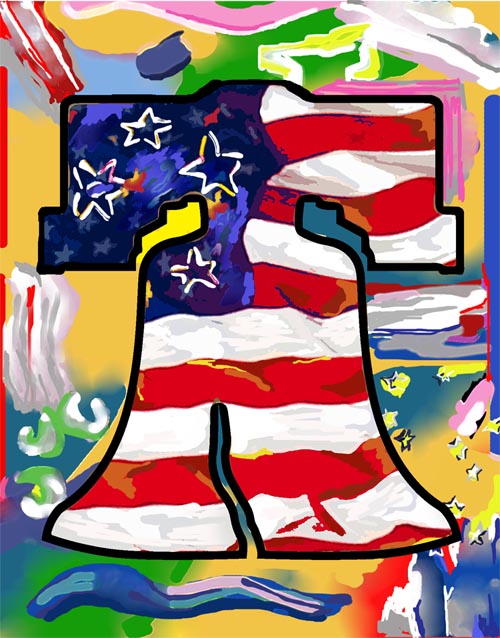
Let Freedom Ring - The Liberty Bell
A Civic Symbol of Pride for the United States
As the Liberty Bell grew in significance, it was frequently used as a symbol of the United States of America. Americans purchased replica Liberty Bells, Liberty Bell toy banks, plates, chairs and all kinds of memorabilia on which the Liberty Bell was incorporated. In World War I, the United States began issuing Liberty Loan war bonds to fund the war effort and these bonds that prominently featured the Liberty Bell. The Liberty Bell even went on trips across the United States where it was viewed by millions of Americans.
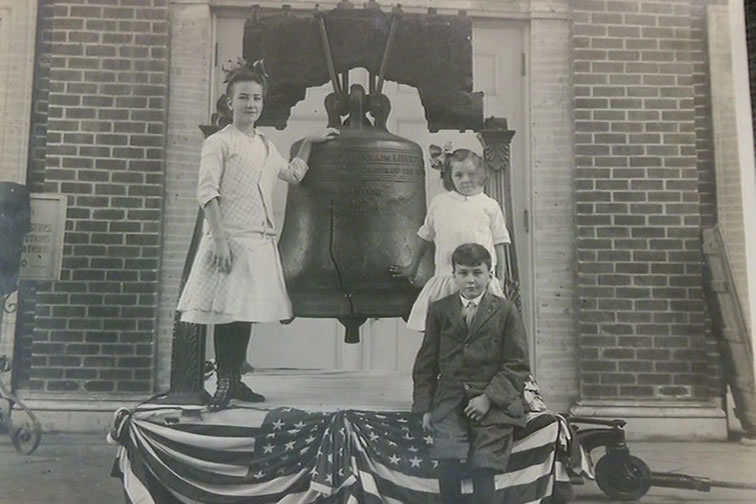
The Liberty Bell in San Francisco
A Civic Symbol of Pride for Philadelphia
No matter how far the Liberty Bell has traveled over the years, Philadelphia has always been its home and the Liberty Bell’s image has become a symbol of Philadelphia’s civic identity. In Philadelphia, the Liberty Bell is so ubiquitous that its likeness can be seen on every street sign in the city. Even the logo of the City of Philadelphia itself that is used on its web site and branding prominently features the Liberty Bell. The Liberty Bell has also been used by Philadelphia’s sports teams. Both the Philadelphia 76ers basketball team and the Philadelphia Phillies baseball team have used the Liberty Bell within their logos to some extent throughout the years. Even Citizens Bank Park, the Phillies’ stadium where all home games are played, has a giant Liberty Bell sign in right-center field. Whenever a Phillies player hits a home run, fans are treated to a celebration when the gigantic Liberty Bell (50 high and 35 wide) comes to life with the bell and clapper swinging side-to-side, and its neon edges lighting up along with lights flashing.
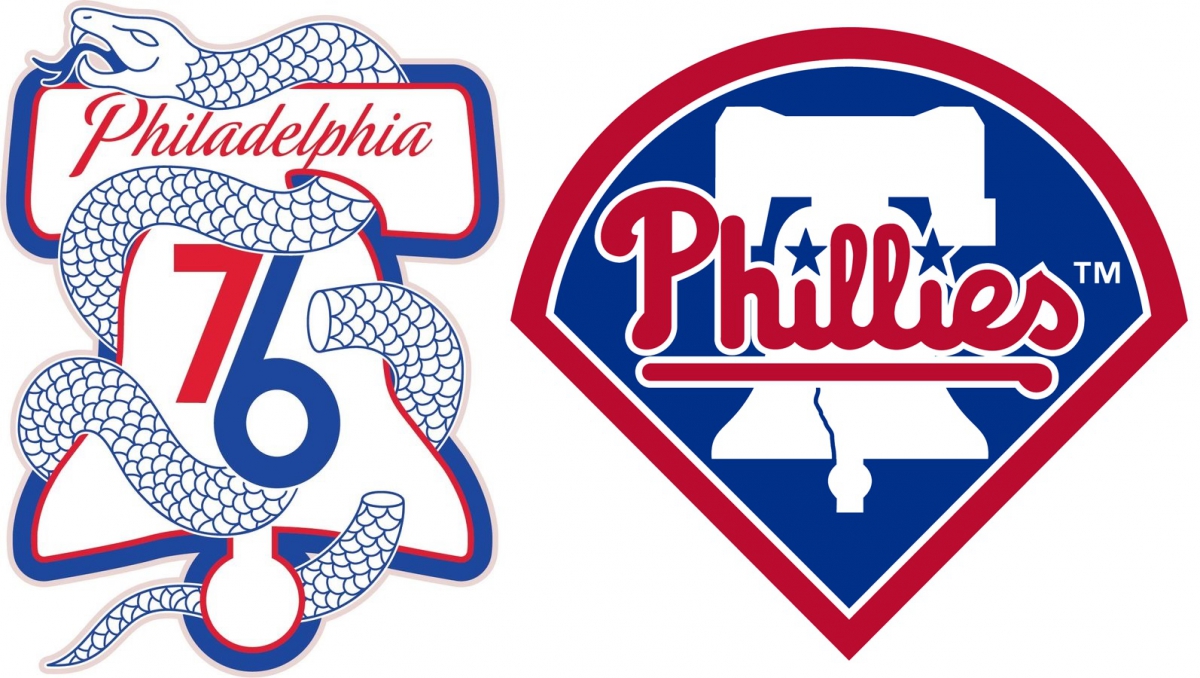
Philadelphia 76ers and Philadelphia Phillies logos featuring The Liberty Bell
The Centennial Bell
If you look up at the bell tower of Independence Hall, you will still see a bell up there, even though the Liberty Bell has not been up there for well over a century. The bell hanging in Independence Hall currently and which rings every hour, at the top of the hour, is known as the Centennial Bell. It was created for the United States’ Centennial and placed in the Independence Hall bell tower on July 4, 1876.
The Centennial Bell contains metal from four different cannons. Two of the cannons are from one of the most important battles in the American Revolution, the Battle of Saratoga in New York, one cannon from the British Side and one cannon from the American Side. The other two cannons are from one of the most important battles in the American Civil War, the Battle of Gettysburg in Pennsylvania, one cannon from the side of the Union, and the other cannon is from a Confederate cannon. Melting these cannons together to create the Centennial Bell was meant to symbolize the friendship that now exists between these once warring factions as the British are today one of America’s greatest allies, and the Union and the Confederacy eventually reunited as the United States of America after the Civil War. The Centennial Bell is far heavier the Liberty Bell, weighing 13,000 pounds, which symbolizes the 1,000 pounds for each of the original thirteen states encompassing the United States. Unlike the Liberty Bell, the Centennial Bell is still in excellent working order, and can be heard ringing to announce the hour, at the top of every hour, from the Independence Hall Bell Tower.
The Bicentennial Bell – The Royal Family’s Perspective
On July 6, 1976, Her Majesty, Queen Elizabeth II of Great Britain presented the Bicentennial Bell to the people of the United States to celebrate America’s 200th birthday. On the Bicentennial Bell, there is an inscription which reads, “For the People of the United States of America From the People of Great Britain. 4 July 1976. LET FREEDOM RING.”
Below is the text from Queen Elizabeth’s moving speech in Philadelphia that still resonates with Americans and visitors alike:
“I speak to you as the direct descendant of King George III. He was the last Crowned Sovereign to rule in this country, and it is therefore with a particular personal interest that I view those events which took place 200 years ago.
It seems to me that Independence Day, the Fourth of July, should be celebrated as much in Britain as in America. Not in rejoicing at the separation of the American Colonies from the British Crown but in sincere gratitude to the Founding Fathers of this great Republic for having taught Britain a very valuable lesson.
We lost the American Colonies because we lacked that statesmanship to know the right time, and the manner of yielding, what is impossible to keep.
But the lesson was learnt. In the next century and a half we kept more closely to the principles of Magna Carta which have been the common heritage of both our countries.
We learnt to respect the right of others to govern themselves in their own ways. This was the outcome of experience learned the hard way in 1776. Without that great act in the cause of liberty performed in Independence Hall two hundred years ago, we could never have transformed an Empire into a Commonwealth!
Ultimately peace brought a renewal of friendship which has continued and grown over the years and has played a vital part in world affairs. Together we have fought in two world wars in the defense of our common heritage of freedom. Together we have striven to keep the peace so dearly won. Together, as friends and allies, we can face the uncertainties of the future, and this is something for which we in Britain can also celebrate the Fourth of July.
This morning I saw the famous Liberty Bell. It came here over 200 years ago when Philadelphia, after London, was the largest English speaking City in the world. It was cast to commemorate the Pennsylvania Charter of Privileges, but is better known for its association with the Declaration of Independence.
Today, to mark the 200th anniversary of that Declaration, it gives me the greatest pleasure, on behalf of the British people, to present a new bell to the people of the United States of America. It comes from the same foundry as the Liberty Bell, but written on the side of this Bicentennial Bell are the words “Let Freedom Ring”.
It is a message in which both our people can join and which I hope will be heard around the world for centuries to come.”
On January 27, 2007, Britain’s Prince Charles and the Duchess of Cornwall Camilla Parker-Bowles
viewed the Liberty Bell during their whirlwind visit to Philadelphia which included many of the sites along The Constitutional Walking Tour.
The Bicentennial Bell once hung in the bell tower of the old Visitors’ Center in Philadelphia (on the site which is now the Museum of the American Revolution), and plans are currently in motion to once again display the Bicentennial Bell in Philadelphia.
Strange But True
On April 6, 2001, at about 9:30AM, just five months before 9/11 (September 11, 2001), a 26 year old deranged man wearing military fatigues visited the former Liberty Bell Pavilion where the Liberty Bell was formerly housed prior to the opening of the Liberty Bell Center, took out a hand-sledge hammer, rushed the Liberty Bell, shouted about God, and wacked the Liberty Bell several times before he was tackled and taken into custody. The man was named Mitchell Guillant, and he was from Nebraska. Mr. Guillant had just participated in a Park Ranger lead program about the Liberty Bell, when all of a sudden, he went berserk and attacked the Liberty Bell. Mr. Guillant was sentenced to nine months in prison, given five years probation and fined $7,093 to cover the costs of repairing the gouge marks that he had made in the Liberty Bell. You can hear more about the attack on the Liberty Bell and other bizarre stories about Philadelphia’s sometimes dark past, ghost stories, and haunted folklore on the
Spirits of ‘76 Ghost Tour.
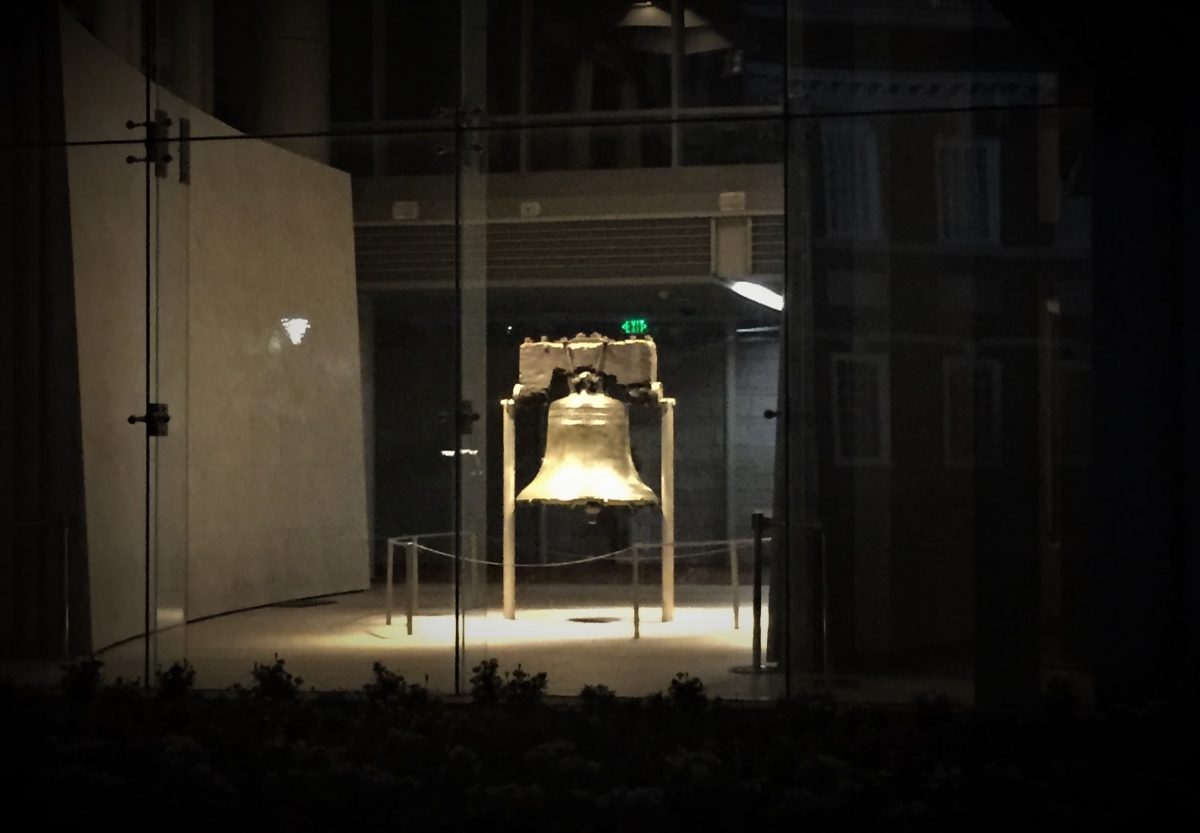
View of The Liberty Bell at night from outside the Liberty Bell Center
The Liberty Bell Center
The Liberty Bell is housed inside of the Liberty Bell Center which opened in 2003 and spans almost an entire city block on 6th Street between Market and Chestnut Streets. The Liberty Bell can be seen from both inside and outside of the Liberty Bell Center. Inside the Liberty Bell Center, the Liberty Bell is on display in a grand chamber that directly faces the Independence Hall Bell Tower where the Liberty Bell once hung. The Liberty Bell can be seen anytime and any day (or night) through large showcase windows on Chestnut Street, close to the Northeast corner at 6th and Chestnut Streets, across the street from Independence Hall. Inside the Liberty Bell Center are exhibits about the history of the Liberty Bell, including original artifacts, photos, x-rays of the crack, a great video, and of course, the Liberty Bell itself.
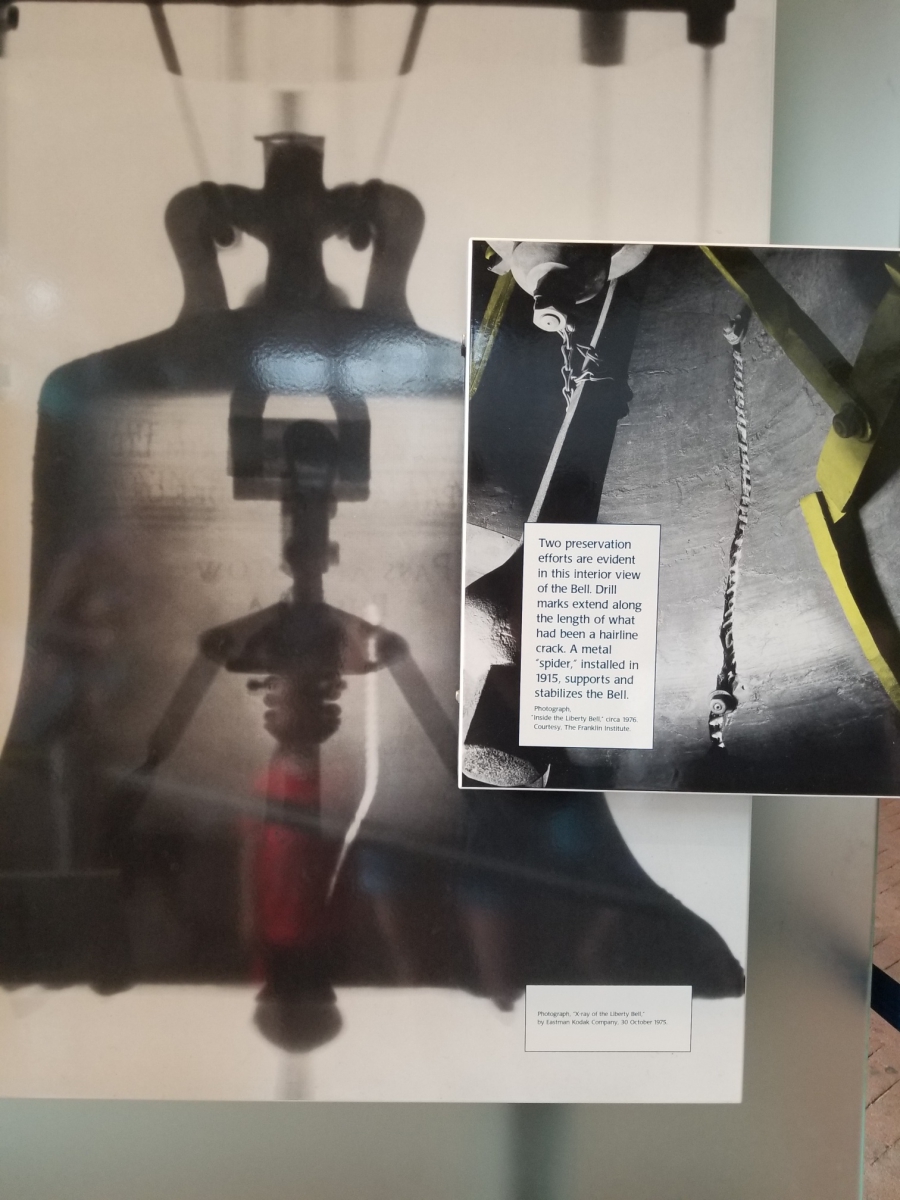
Liberty Bell Center exhibit detailing x-ray of The Liberty Bell
The Liberty Bell is a prominent stop on
The Constitutional Walking Tour (which visits more than 20 sites on an outdoor walking adventure that provides a primary overview of the Independence Park area). Often times, visitors taking The Constitutional Walking Tour will either visit the inside of the Liberty Bell Center just before or after The Constitutional.
You can click
here to buy tickets to The Constitutional Walking Tour of Philadelphia.
You can click here for our guide on how to best visit the interior of the Liberty Bell Center and see the Liberty Bell up close.
Additional Information
526 Market Street (GPS address)
6th & Market Street
Philadelphia, PA 19106
(215) 965-2305







